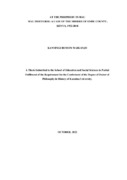AT THE PERIPHERY IN MAU MAU DISCOURSE: A CASE OF THE MBEERE OF EMBU COUNTY, KENYA, 1952-2014
Abstract
The ambiguity of Mau Mau discourse led to multiple narratives about the movement. The elusiveness was evidenced by voices of the past mixing with current views, discovery, access to migrated archives and reparation cases. The reparation case ignited debates on participation in the Mau Mau struggle. In the Mau Mau discourses, the movement was considered Kikuyu, Embu and Ameru affair, disregarding communities’ contribution on the fringes of Mt. Kenya like the Mbeere. To show the contribution of peripheral communities, there was a need to deconstruct the pedagogy of misinformation and represent an accurate picture for collective memory. This study sought to examine the missing narrative of the Mbeere in Mau Mau discourse. The following specific objectives guided the study: to establish the role of the Mbeere chiefs in colonial penetration and administration; to assess the evidence of the contribution of the Mbeere in the Mau Mau struggle; to examine the reasons for exclusion of the Mbeere in Mau Mau discourse and lastly to evaluate the recognition and compensation of the Mbeere Mau Mau veterans by the Kenya government and the British government, respectively. The Post-colonial theory informed this study that critically examines the post-colonial experience of Third World societies. Both primary and secondary data were sourced and used in the study. Archival data was obtained from the Kenya National Archives and Documentation Centre in Nairobi, Nakuru and The National Archives in the United Kingdom. Oral data was collected from informants in Kyeni South, Mbeere North and South in Embu County. This study used focus group discussions and in-depth interviews for data collection, where 59 participants were interviewed. In interviews, purposive sampling was employed where the chiefs pinpointed Mau Mau veterans in their wards. Then snowball sampling strategy was used to identify more respondents knowledgeable about the Mau Mau movement. Respondents for focus group discussions were selected through purposive sampling based on the participation of those above 70 years and who participated in the insurgency. Data were analysed using NVIVO 12 to extract themes that answered the research questions. Selected secondary sources informed the theory, while others complemented data from the primary sources. The proposed study provided a counterpoint to literature that lauded the Kikuyu, Embu and Meru as key participants in the Mau Mau struggle for independence by identifying the Mbeere as (active or passive players) in the war of decolonisation. Additionally, the study findings noted that the Mbeere were left out in the reparation process, but they are hopeful for reparation and memorialisation. The Mau Mau debates will not end soon with the growing attention of the marginalised narratives. The Mbeere involvement in the Mau Mau insurgency as seers was deeper than assumed; they utilised an unmarked villagisation process by scavenging food for the Mau Mau insurgency. They used non-KEM status to evade detection as a tactic of war for insurgency’s sake. These two areas need further research for posterity. Thirdly this study can be replicated in other peripheral communities in Kenya to retell their past. Also, there is a need to rewrite the history of the Mbeere and show nuances of the Mbeere marginalisation in resource allocation and how it intersects with the history of decolonisation. Lastly, review the state of non-Embu (the Kikuyu ahoi and the Kamba) who claimed to have been born into the Embu tribe while the colonial government, the Embu elders and ADC members expressed in 1961 that there was no place for them in the District.
